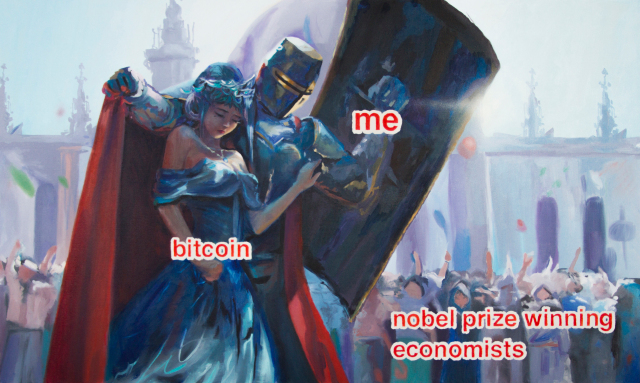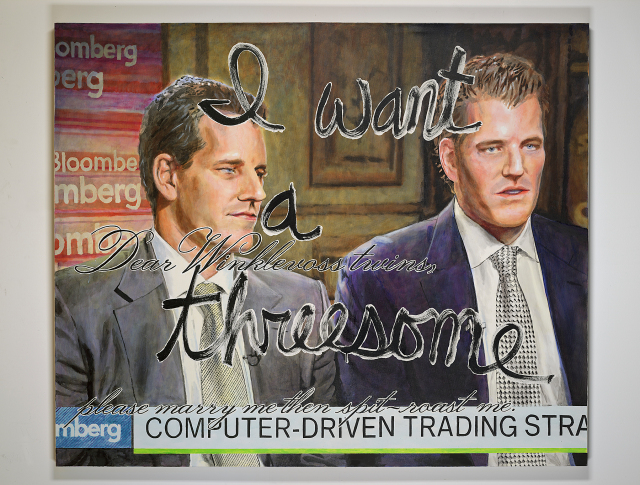The painting “Bitcoin Princess” began life as a social media meme—a cartoon mashed up with ironic commentary designed for mass consumption on Twitter or Instagram. In the illustration, a knight is shielding a princess from a raging crowd. It’s a standard enough scene that could be cropped from a zillion anime movies or manga comic books. But this knight has the word “me” pasted onto his tower shield, the princess is labeled “bitcoin” and the crowd has been dubbed “Nobel Prize winning economists.”
Behold the brave knight defending the future of decentralized finance from a horde of fiat unbelievers!
But is it satire, or celebration, or a mixture of both?
The difficulty of answering that question is precisely why Christine Tien Wang, an artist who lives in San Francisco, saw the meme as perfect fodder for her “Crypto Rich” series of acrylic paintings. Wang thrives on ambivalence, on the murky territory between idealism and greed that is so essential to the blockchain movement. Her current mode of expression—painting exact copies of online memes into elite-gallery eligible flat-screen TV-sized artworks—is its own exercise in textual ambivalence, a recapturing, back into the offline world, of a mode of expression indigenous to the online playground.
It gets confusing. When she uses her phone to show friends photographs she has taken of her paintings, no one can tell the difference from the “original,” she notes, while laughing. And yet when you see the paintings up close in a gallery, you realize, once and for all, that cryptocurrency truly has come of age, because blockchain is now a text that modern artists are appropriating, recontextualizing, and, in Wang’s case, making hilarious.
"Bitcoin Princess," based on a meme originally created by Coin Center communications director Neeraj Agrawal.

Consider Wang’s “Boobs”—a reworking of the infamous 1957 photograph in which a young Sophia Loren directs history’s most notorious side-eye at Jayne Mansfield’s all-conquering cleavage. On display at Art Basel last December—the Miami Beach art show extravaganza that is an annual must-stop for the see-and-be-seen luminaries of the global art world—”Boobs” attracted a steady stream of onlookers furrowing their brows or laughing out loud at its crypto critique.
In “Boobs,” Loren’s head is labeled “Wall Street,” her own breasts have the word “stocks” pasted across them, and Mansfield’s mammary glands are titled “crypto.” If you are blockchain-fluent, you can appreciate the joke on a number of levels. Wall Street/Sophia Loren is both threatened by Mansfield/crypto’s assault on the established order, but also clearly titillated by their lustful promise. She fears their break-out, but she also can’t look away.
"Bitcoin," says Wang, laughing again, "is a set of Double D boobs." It’s impossible for anyone to look away.
“Bitcoin,” says Wang, laughing again, “is a set of Double D boobs.” It’s impossible for anyone to look away.
Christine Wang came by her crypto-fascination honestly, albeit with a dose of tragedy. Her husband, (a data scientist who works at a San Francisco AI startup and is modestly famous for hacking OKCupid to find his true love and soul-partner), clued her into the blockchain all the way back in 2011. Wang invested a modest sum of money buying Bitcoin, but then lost all her holdings in the spectacular 2014 hack-and-crash of Mt. Gox, the Tokyo-based crypto exchange that offered one of the first painful lessons in just how wild and wooly the crypto world could get.
Four years later, she watched, with a mixture of regret and amazement, as the monetary value of bitcoin made its astonishing 2017 run to stratospheric heights. She found herself transfixed by the transformation of bitcoin’s evangelical we-will-change-the-world narrative into a get-rich-quick festival of greed featuring cartoon characters like the Winklevii twins. The explosion of online ephemera accompanying the rocket-ship ride was rich in artistically-fertile contradictions.
“Bitcoin embodied all these utopian fantasies and hopes and aspirations,” says Wang. “And then on the other hand there were these crypto memes and Instagram posts and Twitter posts that were extremely crude.”
"Winklevii"

“I just stole them from the internet,” she says, and started painting. Her intent, just as you might expect from any self-respecting artist caught in the middle of the maelstrom of tech ascendance that is San Francisco in the current moment, was to create commentary that “made sense of the world around me.”
But she’s also clearly in it to crack some jokes.
“I just think it’s so funny,” said Wang. “The community has all of these hopes and dreams and then the memes that come out reveal all this greedy, sexist, misogynist, capitalist, consumerist ambition.”
That’s a mouthful, for certain. But I have to ask her: is she sure that people within the crypto-world get that her aim is poke fun at all the greed? It seems to me that there is no shortage of people who believe in the blockchain and cryptocurrency who would regard the Sophia Loren/Jayne Mansfield meme as an accurate representation of reality. In other words, Wall Street should feel threatened by crypto’s usurpation of established territory in the financial sector.
Wang acknowledges that this is possible, but she observes that to perceive the painting in such a way means that the pro-crypto viewer is then “subjectively placing themselves in the position of Jayne Mansfield’s breasts,” perhaps one of the most sexually objectified pieces of female anatomy in modern pop cultural history.
“They have to identify with Jayne Mansfield’s boobs,” says Wang. “Do you know what I mean?
Whether they get the joke or not, “that’s worth it to me,” says Wang. “Because how many men in crypto can see themselves as objects rather than subjects? I think most people have the fantasy that they are agents of their own lives and of their own narratives and they’re in control.”
Wang does not fear the scrutiny of the crypto-elite. On the contrary, she welcomes it. She tells me that she can’t wait for her first exhibition of her crypto paintings in San Francisco, coming at the Ever Gold gallery in May.
“The reason why I am so excited is the context. Right? San Francisco! Where else can I get an audience that’s so steeped in all of this? Like—they know what HODL means!”
I ask her, as our interview comes to an end, if she would ever think of investing in cryptocurrencies again.
Her eyes widen.
“Buy the DIP!” she declares. And then laughs again, long and hard. Christine Wang provides her own laugh track. She may have lost all her early Bitcoin at Mt. Gox, but she is still having plenty of fun with crypto.
Images courtesy of the artist and Galerie Nagel Draxler.